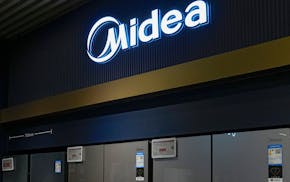Crystal and Garret Cerkvenik have a long list of reasons they are moving their young family from Arizona to the Twin Cities metro area: Family, the four seasons, and above all, better education opportunities for their boys, ages 2 and 4.
Finding the best school district from several states away has meant studying school rankings, including the ones on home listing sites like Zillow. The couple is narrowing the search to the schools that earn the highest ratings across several categories, including test scores and college readiness.
"Because we can pick and choose where we buy, we definitely have tunnel vision," Garret Cerkvenik said.
The real estate axiom about "location, location, location" driving property value has a lot to do with schools. Regardless of whether a buyer has school-aged children, real estate agents say the quality of a school district is often a crucial factor in determining a home's value and resale potential. National home listing sites like Zillow, Redfin or Realtor.com feature ratings of nearby schools ranging from 1 to 10.
But the source and reliability of the ratings aren't always clear. School districts, real estate agents and even the websites themselves caution against using the ratings as the sole criteria for choosing the right school for a student.
"A rating is one tool for a family to look at as they make the decision on a school," said Grace Becker, director of marketing and communications for Eden Prairie schools. "But it should never, ever be the only one."
The numbers on real estate websites often come from GreatSchools, a national nonprofit organization with a mission of helping parents compare schools. The ratings on Homes.com originate with Niche, a company that combines statistical analysis with reviews from students, teachers and parents.
Before becoming a real estate agent, Anna Garnaas-Halvorson taught in St. Paul Public Schools for 14 years. She said it's demoralizing to work hard in a high-poverty school and know that some people may judge its quality solely on a rating that's based, in part, on test scores, which may not factor in the socioeconomic makeup of the school.
"It's kind of devastating that no one's looking at the whole picture," she said, adding that struggling schools can suffer more if people aren't willing to invest in the neighborhoods around them. "It's a mess. Some people dig further, but others see a number and figure that's enough information for them."
Accuracy questions
Both GreatSchools and Niche offer ways for districts to add to their profiles and charge annual fees for extra marketing perks.
In Minnesota, 35 traditional public schools, 16 charter schools, 30 private schools and 11 school districts have paid premium Niche accounts, according to the company. Costs vary from district to district but can rise to tens of thousands of dollars.
GreatSchools CEO Jon Deane said the hope of having rankings on sites like Zillow is to start a conversation among real estate professionals and families about the schools.
The nonprofit pulls state data to give a summary rating that is calculated based on scores in four categories: academic progress, college readiness, equity and test scores. More subjective data points aren't wrapped into the summary score but may be added to a school's profile, Deane said.
"We are not trying to tell people, 'Hey, take this information and make your final decisions based on it,' " Deane said, adding that families should click past the overall rating to read more about a school.
In the Twin Cities area, one group — Great MN Schools (no affiliation with the national GreatSchools) — offers a Minneapolis School Finder website and booklet that rates a city's schools on academics, climate and equity. The nonprofit also organizes a school finder fair, held in January, for Minneapolis families.
"I think there's a lot more acceptance that parents do need data and it does need to be transparent and comparable," said Sheilah Kavaney, director of operations and school support for Great MN Schools. Still, she added, a lot of education data — including disciplinary actions — isn't comparable from school to school.
St. Paul Public Schools spokeswoman Erica Wacker encourages families to schedule a tour or attend an open house to learn about a school.
"SPPS does not invest time or resources into ratings websites," she wrote in a statement. "These sites do not consult with the district or individual schools on their listings. Much of the data that these websites display is outdated or from unfamiliar sources."
For example, the demographic data listed on GreatSchools for Hidden River Middle School in St. Paul did not match internal district data, Wacker said, and many of the school names on the site are not accurate.
Good schools add value
Real estate agent Vicki Peters advertises herself as an expert on the Wayzata district, one that's highly sought after by families looking for top-rated schools. That's how the Cerkveniks found her.
"As realtors, we do not give advice or information on school ratings, but we can point them to websites like GreatSchools," Peters said.
"Some clients get really stuck on the number and won't look below a certain rating, but I try to tell them that every child is different and every experience is different."
Still, Peters said a home in a highly rated school district can list for up to $50,000 more than an identical one in a lower-rated district.
"It matters in that sense," she said.
In a statement, Wayzata Schools spokeswoman Amy Parnell said, "We are proud that Wayzata Schools consistently earn high ratings" on platforms like Niche, adding that high ratings help attract families and "bolster a sense of pride among students, staff and the broader community."
Becker, Eden Prairie Schools' marketing and communications director, agreed.
The district is one of Niche's paid partner districts, though Becker said paying doesn't influence rankings, which are calculated based on first-person reviews and third-party data. Eden Prairie Schools pays about $7,000 for services from Niche.
Eden Prairie school leaders also periodically give presentations to real estate agents to help them better understand the district's offerings and boost the district via word of mouth.
"From my perspective, it's only possible to get a feel for a school by hearing from people about their experiences," she said. "Don't limit yourself to a number on a screen, even if it's an excellent number. Take the next step and dive deeper."
Rankings vs. experience
Colin Sokolowski, executive director of public relations for Mounds View Public Schools, said he doesn't pay attention to external ratings. Instead, the district focuses on feedback gathered from internal surveys of its families.
"The bottom line is that external ratings don't drive our continuous improvements," he said. "Where the rubber hits the road is the answer to the question, 'Is the student having a good experience?' That's the data that matters to us."
In blending their families, St. Paul parents Gjert and Meg Skaar considered a few suburban school districts. They talked to Garnaas-Halvorson, their real estate agent, about options and did some research online. They ultimately decided to keep their four children at Randolph Heights Elementary School in St. Paul and found a five-bedroom house with enough space in a neighborhood with kids who also attend Randolph Heights.
They are set to close on the house next month.
"I definitely noticed those school ratings on Zillow," Meg Skaar said. "But we didn't use them. I went off our experiences. Ultimately, you have to do what's best for your family and not pay attention to too many external sources."

Accomplished climber, photographer who recently moved from St. Paul missing on mountain

Walz: State had no advance notice of federal raid in Minneapolis

DOGE cuts federal money for upgrades at Velveeta plant in New Ulm

Five members of Minneapolis Highs street gang found guilty of racketeering conspiracy

